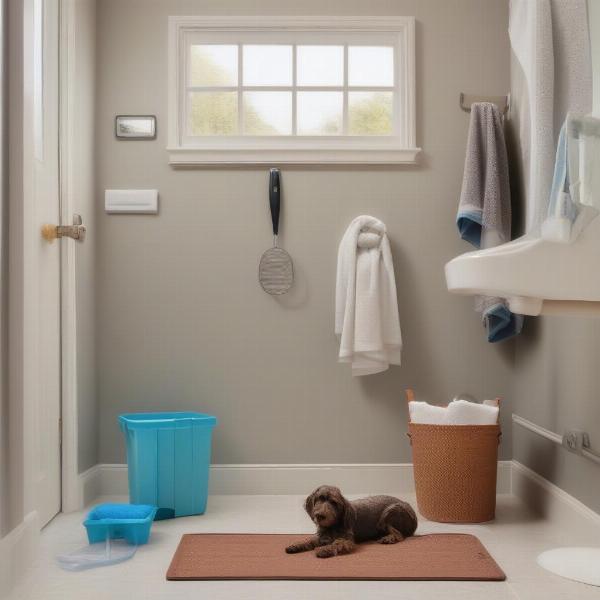Splash dog! Those two words can bring both joy and a little bit of chaos to mind. Whether your furry friend loves a dip in the lake, a romp in the puddles, or just a good shake after bath time, dealing with a wet dog is a common part of pet ownership. This guide will cover everything you need to know about minimizing the mess, keeping your dog safe around water, and making bath time a more pleasant experience for both of you.
Understanding Your Splash Dog
Not all dogs are created equal when it comes to water. Some breeds are natural swimmers, while others prefer to stay dry. Understanding your dog’s individual personality and breed tendencies can help you manage their splashing habits. Is your dog a retriever who loves fetching in the water? Or a small terrier who prefers to avoid puddles? Tailoring your approach to your dog’s specific needs is key.
For dogs who love to swim, ensuring their safety is paramount. Never leave them unsupervised near water, and consider investing in a dog life vest, especially if they are swimming in open water. Even strong swimmers can get into trouble, so it’s always best to err on the side of caution.
Minimizing the Mess After a Splash
Dealing with a wet, muddy dog can be a challenge. Here are a few tips to minimize the mess:
- Invest in absorbent dog towels. Microfiber towels are particularly effective at quickly drying your dog’s fur and minimizing shaking.
- Create a designated “drying station” near the door. This could be a mat, a towel, or even a specific area of your bathroom.
- Use a dog dryer. For dogs with thick or double coats, a dog dryer can significantly speed up the drying process and help prevent skin issues.
 Setting Up a Dog Drying Station
Setting Up a Dog Drying Station
Bath Time Bliss: Splish, Splash, Without the Crash
Bath time doesn’t have to be a battle. Here are a few tips for making the experience more enjoyable for both you and your dog:
- Use a dog washing apron to protect your clothes from getting wet.
- Choose a dog-specific shampoo and conditioner. Human shampoos can disrupt the pH balance of a dog’s skin.
- Introduce your dog to water gradually. Start with shallow baths and lots of positive reinforcement.
- Make bath time fun! Use toys, treats, and a gentle voice to create a positive association with bathing. A zero splash dog bowl can be a great way to keep them occupied during the process.
Is Your Dog a Splash Hazard?
Does your dog create a tidal wave every time they take a drink? A no splash dog bowl might be just what you need! These specially designed bowls minimize splashing and keep your floors dry.
Conclusion
Dealing with a “splash dog” is a common part of pet ownership. By understanding your dog’s individual needs, taking steps to minimize the mess, and making bath time a positive experience, you can enjoy all the joys of dog ownership without the added stress of constant cleaning. Remember to prioritize safety around water, especially for dogs who love to swim. With a little preparation and the right tools, you and your splash dog can coexist happily and cleanly.
FAQ
- How often should I bathe my dog? It depends on the breed and lifestyle, but generally, once a month is sufficient. More frequent baths can strip their skin of essential oils.
- What can I do if my dog is afraid of water? Introduce them to water slowly and positively. Start with shallow puddles and reward them for any interaction with water.
- What type of dog towel is most absorbent? Microfiber towels are excellent for absorbing water and drying dogs quickly.
- Are dog dryers safe to use? Yes, as long as you follow the manufacturer’s instructions and use a low heat setting.
- How can I prevent my dog from tracking mud into the house? Wipe their paws with a towel or use a paw cleaner before they come inside.
- What should I do if my dog ingests a large amount of water while swimming? Monitor them closely for signs of water intoxication, such as vomiting, lethargy, or difficulty breathing. If you are concerned, contact your veterinarian immediately.
- Are there any breeds of dogs that are particularly prone to splashing? While any dog can splash, breeds with long, droopy ears or those who love to shake their fur vigorously are often more prone to creating a mess.
Related Articles
About ILM Dog
ILM Dog is your trusted resource for expert advice on all aspects of dog care, from breed selection and puppy care to senior dog health and behavior training. We provide practical guidance and helpful tips to ensure your furry friend lives a happy, healthy life. Whether you’re a new dog owner or a seasoned pro, our comprehensive resources cover everything you need to know about nutrition, grooming, exercise, and finding the perfect products for your companion. Contact us for any dog-related query at [email protected] or +44 20-3965-8624.